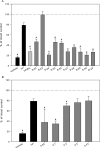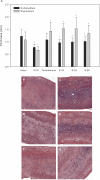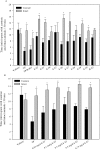Nonsteroidal selective androgen receptor modulators enhance female sexual motivation
- PMID: 20444881
- PMCID: PMC2913771
- DOI: 10.1124/jpet.110.168880
Nonsteroidal selective androgen receptor modulators enhance female sexual motivation
Abstract
Women experience a decline in estrogen and androgen levels after natural or surgically induced menopause, effects that are associated with a loss of sexual desire and bone mineral density. Studies in our laboratories have shown the beneficial effects of selective androgen receptor modulators (SARMs) in the treatment of osteoporosis and muscle wasting in animal models. A series of S-3-(phenoxy)-2-hydroxy-2-methyl-N-(4-cyano-3-trifluoromethyl-phenyl)-propionamide analogs was synthesized to evaluate the effects of B-ring substitutions on in vitro and in vivo pharmacologic activity, especially female sexual motivation. The androgen receptor (AR) relative binding affinities ranged from 0.1 to 26.5% (relative to dihydrotestosterone) and demonstrated a range of agonist activity at 100 nM. In vivo pharmacologic activity was first assessed by using male rats. Structural modifications to the B-ring significantly affected the selectivity of the SARMs, demonstrating that single-atom substitutions can dramatically and unexpectedly influence activity in androgenic (i.e., prostate) and anabolic (i.e., muscle) tissues. (S)-N-(4-cyano-3-trifluoromethyl-phenyl)-3-(3-fluoro,4-chlorophenoxy)-2-hydroxy-2-methyl-propanamide (S-23) displayed full agonist activity in androgenic and anabolic tissues; however, the remaining SARMs were more prostate-sparing, selectively maintaining the size of the levator ani muscle in castrated rats. The partner-preference paradigm was used to evaluate the effects of SARMs on female sexual motivation. With the exception of two four-halo substituted analogs, the SARMs increased sexual motivation in ovariectomized rats, with potency and efficacy comparable with testosterone propionate. These results indicate that the AR is important in regulating female libido given the nonaromatizable nature of SARMs and it could be a superior alternative to steroidal testosterone preparations in the treatment of hypoactive sexual desire disorder.
Figures





Comment in
-
Re.: Nonsteroidal selective androgen receptor modulators enhance female sexual motivation.J Urol. 2011 May;185(5):1976-7. doi: 10.1016/S0022-5347(11)60196-1. J Urol. 2011. PMID: 22088744 No abstract available.
References
-
- Abraham GE. (1974) Ovarian and adrenal contribution to peripheral androgens during the menstrual cycle. J Clin Endocrinol Metab 39:340–346 - PubMed
-
- Allan GF, Tannenbaum P, Sbriscia T, Linton O, Lai MT, Haynes-Johnson D, Bhattacharjee S, Zhang X, Sui Z, Lundeen SG. (2007) A selective androgen receptor modulator with minimal prostate hypertrophic activity enhances lean body mass in male rats and stimulates sexual behavior in female rats. Endocrine 32:41–51 - PubMed
-
- Blasberg ME, Robinson S, Henderson LP, Clark AS. (1998) Inhibition of estrogen-induced sexual receptivity by androgens: role of the androgen receptor. Horm Behav 34:283–293 - PubMed
Publication types
MeSH terms
Substances
Grants and funding
LinkOut - more resources
Full Text Sources
Research Materials

